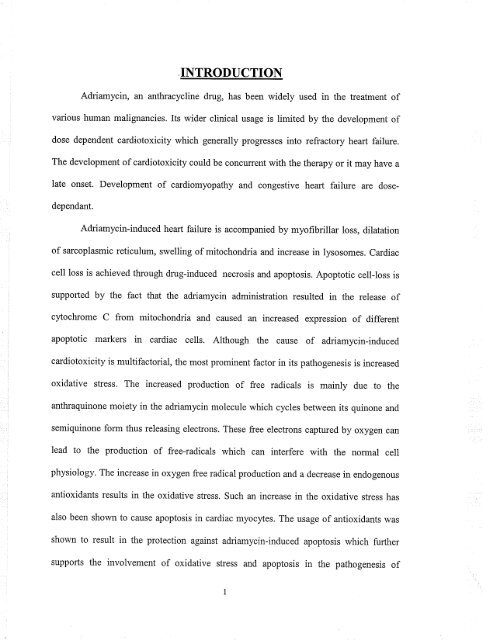il\VOLVEMENT OF RETII\OIC ACID II{ - MSpace at the University of ...
il\VOLVEMENT OF RETII\OIC ACID II{ - MSpace at the University of ...
il\VOLVEMENT OF RETII\OIC ACID II{ - MSpace at the University of ...
You also want an ePaper? Increase the reach of your titles
YUMPU automatically turns print PDFs into web optimized ePapers that Google loves.
INTRODUCTION<br />
Adriamycin, an anthracycline drug, has been widety used in <strong>the</strong> tre<strong>at</strong>ment <strong>of</strong><br />
various human malignancies. Its wider clinical usage is limited by <strong>the</strong> development <strong>of</strong><br />
dose dependent cardiotoxicity which generally progresses into refractory heart failure.<br />
The development <strong>of</strong> cardiotoxicity could be concurrent with <strong>the</strong> <strong>the</strong>rapy or it may have a<br />
l<strong>at</strong>e onset. Development <strong>of</strong> cardiomyop<strong>at</strong>hy and congestive heart failure are dosedependant.<br />
Adriamycin-induced heart failure is accompanied by my<strong>of</strong>ibriliar loss, dil<strong>at</strong><strong>at</strong>ion<br />
<strong>of</strong> sarcoplasmic reticulum, swelling <strong>of</strong> mitochondria and increase in lysosomes. Cardiac<br />
cell loss is achieved through drug-induced necrosis and apoptosis. Apoptotic cell-loss is<br />
supported by <strong>the</strong> fact th<strong>at</strong> <strong>the</strong> adriamycin administr<strong>at</strong>ion resulted in <strong>the</strong> release <strong>of</strong><br />
cytochrome C from mitochondria and caused an increased expression <strong>of</strong> different<br />
apoptotic markers in cardiac cells. Although <strong>the</strong> cause <strong>of</strong> adriamycin-induced<br />
cardiotoxicity is multifactorial, <strong>the</strong> most prominent factor in its p<strong>at</strong>hogenesis is increased<br />
oxid<strong>at</strong>ive stress. The increased production <strong>of</strong> free radicals is mainly due to <strong>the</strong><br />
anthraquinone moiety in <strong>the</strong> adriamycin molecule which cycles between its quinone and<br />
semiquinone form thus releasing electrons. These free electrons captured by oxygen can<br />
lead to <strong>the</strong> production <strong>of</strong> free-radicals which can interfere with <strong>the</strong> normal cell<br />
physiology. The increase in oxygen free radical production and a decrease in endogenous<br />
antioxidants results in <strong>the</strong> oxid<strong>at</strong>ive stress. Such an increase in <strong>the</strong> oxid<strong>at</strong>ive stress has<br />
also been shown to cause apoptosis in cardiac myocytes. The usage <strong>of</strong> antioxidants was<br />
shown to result in <strong>the</strong> protection against adriamycin-induced apoptosis which fur<strong>the</strong>r<br />
supports <strong>the</strong> involvement <strong>of</strong> oxid<strong>at</strong>ive stress and apoptosis in <strong>the</strong> p<strong>at</strong>hogenesis <strong>of</strong>







![an unusual bacterial isolate from in partial fulf]lment for the ... - MSpace](https://img.yumpu.com/21942008/1/190x245/an-unusual-bacterial-isolate-from-in-partial-fulflment-for-the-mspace.jpg?quality=85)





![in partial fulfil]ment of the - MSpace - University of Manitoba](https://img.yumpu.com/21941988/1/190x245/in-partial-fulfilment-of-the-mspace-university-of-manitoba.jpg?quality=85)


